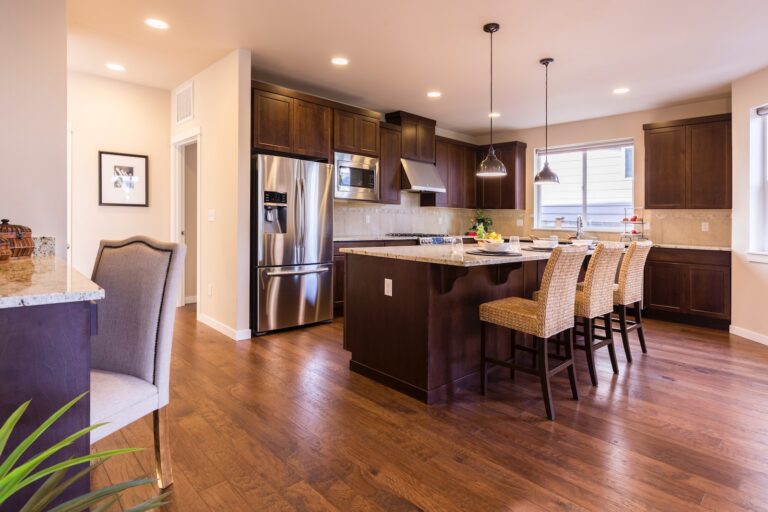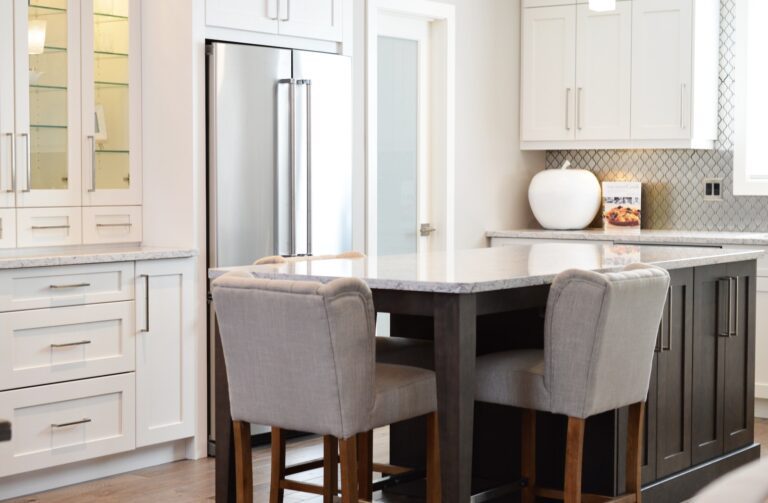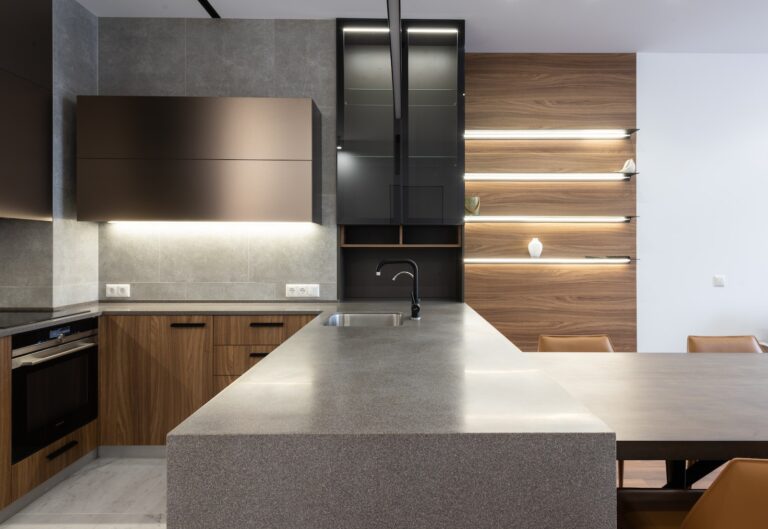How To Measure And Cut Crown Molding For Kitchen Cabinets?
Crown molding is a beautiful and elegant addition to any kitchen cabinet. However, it can be tricky to measure and cut perfectly, especially if you’re not familiar with the process. In this article, we’ll guide you through the steps of measuring and cutting crown molding for your kitchen cabinets. By the end of this guide, you’ll have the skills and confidence to achieve a polished and professional finish. So, let’s get started!
- Measure the length and width of the cabinet top using a tape measure.
- Cut the molding to the length of the cabinet top using a miter saw.
- Mark the angle of the corner using a protractor and cut the molding to fit using the miter saw.
- Attach the molding to the cabinet using a nail gun or screws.
- Fill any gaps with wood putty and sand the surface for a smooth finish.

How To Measure and Cut Crown Molding for Kitchen Cabinets?
Crown molding is a popular decorative element that can add a touch of elegance to your kitchen cabinets. However, measuring and cutting it can be a daunting task, especially if you are new to DIY projects. In this article, we will guide you through the steps to measure and cut crown molding for kitchen cabinets.
Step 1: Measure the Length of Your Cabinets
Before you start cutting the crown molding, you need to measure the length of your cabinets. Use a tape measure to measure the distance between the two corners of your cabinet. Note down the measurement as it will help you determine the length of the crown molding you need.
Tip:
You can use a digital measuring tool for more accurate measurements.
Step 2: Choose the Type of Crown Molding
There are various types of crown molding available in the market, such as wood, MDF, and polyurethane. Choose the type of crown molding that matches the style of your kitchen cabinets. Also, consider the durability, cost, and maintenance of each type.
Benefits of Wood Crown Molding:
– Durable and long-lasting
– Can be stained or painted to match the color of your cabinets
– Adds a classic and traditional look to your kitchen
Benefits of MDF Crown Molding:
– Cost-effective
– Easy to install and maintain
– Can be painted to match the color of your cabinets
Benefits of Polyurethane Crown Molding:
– Lightweight and easy to handle
– Resistant to water and moisture
– Can be painted to match the color of your cabinets
Step 3: Cut the Crown Molding
Use a miter saw to cut the crown molding at a 45-degree angle. Place the crown molding upside down on the saw table and adjust the angle of the saw to 45 degrees. Cut the molding at the desired length.
Tip:
Make sure to cut the crown molding slightly longer than the length of your cabinets to ensure a perfect fit.
Step 4: Install the Crown Molding
Apply a bead of adhesive to the back of the crown molding and attach it to the top of your cabinets. Use a nail gun to secure the molding to the cabinet.
Tip:
Use a level to ensure that the crown molding is straight and even.
Step 5: Fill in the Gaps
Use a wood filler to fill in any gaps between the crown molding and the cabinet. Sand the filler once it dries to create a smooth surface.
Tip:
Make sure to choose a wood filler that matches the color of your cabinets.
Step 6: Sand and Paint the Crown Molding
Sand the crown molding to create a smooth surface. Apply a primer to the molding and let it dry. Once the primer is dry, paint the molding with the desired color.
Tip:
Use a paint that is specifically designed for wood or MDF crown molding.
Step 7: Clean Up
Clean up any sawdust or debris from your work area. Use a vacuum or a damp cloth to remove any dust or debris from the cabinets and the crown molding.
Step 8: Enjoy Your New Crown Molding
Once the paint is dry, you can enjoy your new crown molding. It will add a touch of elegance and sophistication to your kitchen cabinets.
Benefits of Crown Molding:
– Enhances the visual appeal of your kitchen cabinets
– Adds value to your home
– Creates a cohesive and stylish look in your kitchen
Crown Molding vs. Other Decorative Elements
Crown molding is not the only decorative element that you can add to your kitchen cabinets. Here are some other options:
Wainscoting:
– Adds texture and depth to your cabinets
– Can be painted or stained to match the color of your cabinets
– Requires more work and skill to install
Corbels:
– Adds a rustic and vintage look to your cabinets
– Can be made from wood or metal
– Requires additional support for installation
Trim:
– Adds a clean and modern look to your cabinets
– Can be painted or stained to match the color of your cabinets
– Requires precision cutting and installation
Conclusion
Measuring and cutting crown molding for kitchen cabinets can seem overwhelming, but it is a DIY project that anyone can do with the right tools and guidance. Follow these steps to add a touch of elegance and sophistication to your kitchen cabinets.
Frequently Asked Questions
What tools do I need to measure and cut crown molding for kitchen cabinets?
To measure and cut crown molding for kitchen cabinets, you will need a tape measure, a miter saw, a coping saw, a pencil, and safety equipment such as goggles and gloves. A level and a straight edge can also be helpful to ensure accuracy.
When measuring, make sure to measure twice and cut once. Double check your measurements before making any cuts, and use the appropriate safety equipment to protect yourself while using power tools.
How do I measure the length of crown molding for my kitchen cabinets?
To measure the length of crown molding for your kitchen cabinets, first measure the length of the cabinet from one end to the other. Add a few inches to this measurement to allow for any corners or angles. Next, measure the height of the cabinet from the top to the bottom. This will give you the length and height of the crown molding needed for each cabinet.
When measuring for corners or angles, it’s important to take into account the angle of the corner and the thickness of the molding. You may need to make adjustments to the angle of your cuts to ensure a snug fit.
How do I cut crown molding for kitchen cabinets?
To cut crown molding for kitchen cabinets, you will need to use a miter saw and a coping saw. Start by measuring the length of the molding needed for each cabinet, and mark the measurements on the molding with a pencil.
Next, set the miter saw to the appropriate angle for the corner or angle you are cutting. Hold the molding against the saw fence and make the cut.
For inside corners, use a coping saw to remove the excess wood from the back of the molding to create a snug fit. For outside corners, make a compound miter cut to ensure a snug fit.
What is the best way to install crown molding on kitchen cabinets?
The best way to install crown molding on kitchen cabinets is to use a nail gun and wood glue. Apply a small amount of wood glue to the back of the molding, and then use a nail gun to secure it to the cabinet.
Start at one end of the cabinet and work your way around, securing the molding with nails and glue as you go. Use a level to ensure the molding is straight, and make any necessary adjustments before the glue sets.
What are some tips for cutting crown molding for kitchen cabinets?
Some tips for cutting crown molding for kitchen cabinets include measuring twice and cutting once, using a miter saw and coping saw for precision cuts, and using a straight edge and level to ensure accuracy.
It’s also important to take into account the angle of the corner and the thickness of the molding when making cuts. Practice on scrap pieces of molding before making cuts on the actual molding, and always use safety equipment to protect yourself while using power tools.

Installing CABINET CROWN for BEGINNERS – A Simpler Method
In conclusion, measuring and cutting crown molding for kitchen cabinets may seem like a daunting task, but with the right tools and techniques, it can be a straightforward process. Remember to take accurate measurements and make precise cuts to ensure a seamless fit. It’s also important to have patience and take your time during the installation process to achieve the best results.
By following the steps outlined in this guide, you’ll be able to measure and cut crown molding like a pro. With a bit of practice, you’ll be able to transform your kitchen cabinets into a stunning focal point that adds value and style to your home. Don’t be afraid to experiment with different molding styles and finishes to create a look that’s uniquely yours.
In summary, measuring and cutting crown molding requires precision and attention to detail. With the right tools and techniques, anyone can achieve a professional-looking finish. So go ahead and give it a try – you may be surprised at how easy it can be!






